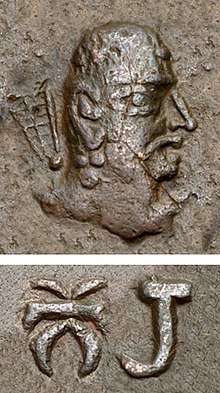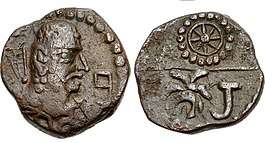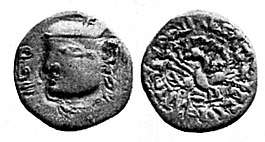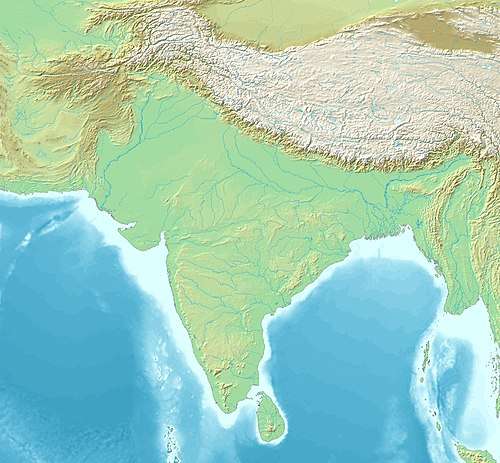Toramana
Toramana also called Toramana Shahi Jauvla[2] (Gupta script: ![]()
![]()
![]()
![]()
![]()
![]()
![]()
![]()
![]()
![]()
![]()
| Toramana | |
|---|---|
| Ruler of the Alchon Huns | |
 | |
| Reign | 493-515 |
| Predecessor | Mehama |
| Successor | Mihirakula |
The Sanjeli inscription of Toramana speaks of his conquest and control over Malwa and Gujarat. His territory also included Uttar Pradesh, Rajasthan and Kashmir.[7] He probably went as far as Kausambi, where one of his seals was discovered.
According to the Rīsthal inscription, discovered in 1983, the Aulikara king Prakashadharma of Malwa defeated him.[8][9]
Overview
Toramana is known from Rajatarangini, through coins and inscriptions.
Punjab inscription
In the Khurā inscription (495-500, from the Salt Range in Punjab and now in Lahore), Toramana assumes the Indian regnal titles in addition to central Asian ones: Rājādhirāja Mahārāja Toramāṇa Shahi Jauvla[10][11][12]. Among which Shahi is considered to be his Title and Jauvla being an epithet or Biruda. This is a Buddhist record in hybrid Sanskrit, recording the gift of a monastery (vihāra) to members of the Mahīśāsaka school.[13][14]
Gwalior inscription of Mihirakula

In the Gwalior inscription of Mihirakula, from Gwalior in northern Madhya Pradesh, India, and written in Sanskrit, Toramana is described as:
"A ruler of [the earth], of great merit, who was renowned by the name of the glorious Tôramâna; by whom, through (his) heroism that was specially characterized by truthfulness, the earth was governed with justice."
Eran Boar inscription


The Eran Boar inscription (in Eran, Malwa, 540 km south of New Delhi, state of Madhya Pradesh) of his first regnal year indicates that eastern Malwa was included in his dominion. The Eran Boar inscription was erected in honor of the deity Vishnu as his avatar, Varaha.
Om ! Victorious is the god (Vishnu), who has the form of a Boar; who, in the act of lifting up the earth {out of the waters}, caused the mountains to tremble with the blows of {his} hard snout ; {and) who is the pillar {for the support) of the great house which is the three worlds !
— Eran Boar Inscription
The statue is of the deity in form of a boar, with engravings display it protecting rishis and uphilding Dharma. Additionally, the statue contains Sanskrit inscriptions inscribed on the neck of the boar, in 8 lines of in Brahmi script. It also records the building of the temple in which the current Varaha image stands, by Dhanyavishnu, the younger brother of the deceased Maharaja Matrivishnu.[15] The first line of the inscription, made after 484/85 CE mentions the "Maharajadhiraja Toramana" ("The great king of king Toramana")[1] and reads:
"In year one of the reign of the King of Kings Sri-Toramana, who rules the world with splendor and radiance...."
Sack of Kausambi
The presence of seals in the name of "Toramana" and "Hunaraja" in Kausambi, suggests that the city was probably sacked by the Alkhons under Toramana in 497-500.[1][17][18][19]
Defeats




| Alchon Huns (400–670 CE) | |||||||||||||||||||||||||||||||||||||||
|---|---|---|---|---|---|---|---|---|---|---|---|---|---|---|---|---|---|---|---|---|---|---|---|---|---|---|---|---|---|---|---|---|---|---|---|---|---|---|---|
|
|||||||||||||||||||||||||||||||||||||||
According to the Rishtal stone-slab inscription, discovered in 1983, the Aulikara king Prakashadharma of Malwa defeated him in 515 CE.[26][1]
Toramana may also have been defeated by the Indian Emperor Bhanugupta of the Gupta Empire in 510 A.D. according to the Eran inscription, although the "great battle" to which Bhanagupta participated is not explicited.[27][28][29]
A few silver coins of Toramana closely followed the Gupta silver coins. The only difference in the obverse is that the king's head is turned to the left. The reverse retains the fantailed peacock and the legend is almost similar, except the change of name to Toramana Deva.[30][31]
A Jaina work of the 8th century, the Kuvalayamala states that he lived in Pavvaiya on the bank of the Chandrabhaga and enjoyed the sovereignty of the world.[32]
Successor
Toramana was succeeded by his son Mihirakula.[33]
See also
- Hephthalite Empire
- Mihirakula
- Alchon Huns
Notes
- Hans Bakker 24th Gonda lecture
- Agrawal, Ashvini (1989). Rise and Fall of the Imperial Guptas. Motilal Banarsidass Publ. ISBN 978-81-208-0592-7.
- Fleet, John Faithfull (1960). Inscriptions Of The Early Gupta Kings And Their Successors. p. 162.
- Grousset, Rene (1970). The Empire of the Steppes. Rutgers University Press. pp. 70-71. ISBN 0-8135-1304-9.
- "the Huna emperor Toramana" in Agrawal, Ashvini (1989). Rise and Fall of the Imperial Guptas. Motilal Banarsidass Publ. p. 251. ISBN 9788120805927.
- Fleet, John Faithfull (1960). Inscriptions Of The Early Gupta Kings And Their Successors. pp. 158–161.
- Dani, Ahmad Hasan (1999). History of Civilizations of Central Asia: The crossroads of civilizations, A.D. 250 to 750. Motilal Banarsidass Publ. p. 142. ISBN 8120815408. Retrieved 5 November 2012.
- Ojha, N.K. (2001). The Aulikaras of Central India: History and Inscriptions, Chandigarh: Arun Publishing House, ISBN 81-85212-78-3, pp.48-50
- Salomon, Richard (1989). "New Inscriptional Evidence For The History Of The Aulikaras of Mandasor". Indo-Iranian Journal. 32 (1): 27. ISSN 0019-7246. JSTOR 24654606.
- Agrawal, Ashvini (1989). Rise and Fall of the Imperial Guptas. Motilal Banarsidass Publ. ISBN 978-81-208-0592-7.
- Katariya, Adesh (25 November 2007). Ancient History of Central Asia: Yuezhi origin Royal Peoples: Kushana, Huna, Gurjar and Khazar Kingdoms. Adesh Katariya.
- Gupta, Parmanand (1977). Geographical Names in Ancient Indian Inscriptions. Concept Publishing Company.
- "Siddham. The Asian Inscription Database | IN00101 Khura Inscription of Toramana". Retrieved 19 November 2019.
- Burgess (1892). Epigraphia Indica Vol 1. Archaeological Society of India. pp. 238–245.
- Fleet (1888)
- Coin Cabinet of the Kunsthistorisches Museum Vienna
- Indian History, Allied Publishers p.81
- Dynastic History of Magadha, Cir. 450-1200 A.D., by Bindeshwari Prasad Sinha p.70
- Geography from Ancient Indian Coins & Seals, by Parmanand Gupta p.175
- Dani, Ahmad Hasan; Litvinsky, B. A. (1996). History of Civilizations of Central Asia: The crossroads of civilizations, A.D. 250 to 750. UNESCO. p. 175. ISBN 9789231032110.
- CNG Coins
- The Identity of Prakasaditya by Pankaj Tandon, Boston University
- Fleet, John Faithfull (1960). Inscriptions Of The Early Gupta Kings And Their Successors. pp. 158–161.
- Tripathi, Rama S. (1989). History of Kanauj: To the Moslem Conquest. Motilal Banarsidass Publ. p. 45 Note 1. ISBN 9788120804043.
- Smith, Vincent Arthur; Edwardes, S. M. (Stephen Meredyth) (1924). The early history of India : from 600 B.C. to the Muhammadan conquest, including the invasion of Alexander the Great. Oxford : Clarendon Press. p. Plate 2.
- Ojha, N.K. (2001). The Aulikaras of Central India: History and Inscriptions, Chandigarh: Arun Publishing House, ISBN 81-85212-78-3, pp.48-50
- Archaeological Excavations in Central India: Madhya Pradesh and Chhattisgarh, by Om Prakash Misra p.7
- Encyclopaedia of Indian Events & Dates by S. B. Bhattacherje A15
- The Classical Age by R.K. Pruthi p.262
- Gupta, P.L. (2000). Coins, New Delhi: National Book Trust, ISBN 81-237-1887-X, p.78
- The Identity of Prakasaditya by Pankaj Tandon p.661, with photograph
- Mahajan V.D. (1960, reprint 2007). Ancient India, S.Chand & Company, New Delhi, ISBN 81-219-0887-6, p.519
- "Gwalior Stone Inscription of Mihirakula" (PDF). Project South Asia. Archived from the original (PDF) on 12 August 2011. Retrieved 5 April 2009.
| Preceded by Khingila I |
Tegin of the Alchon Huns | Succeeded by Mihirakula |
